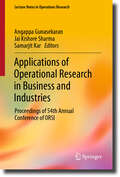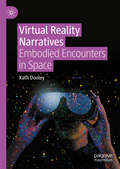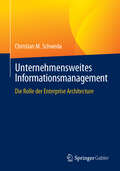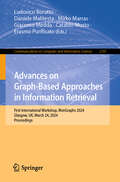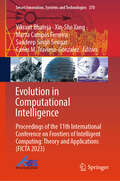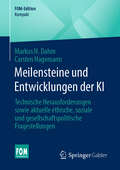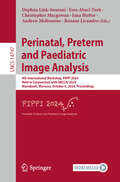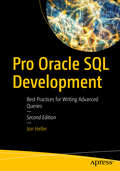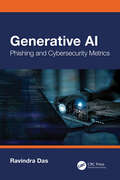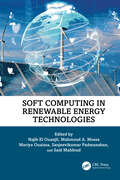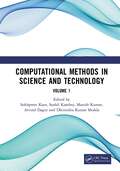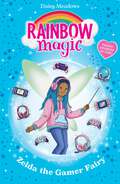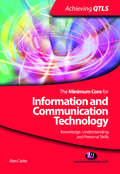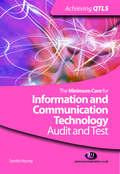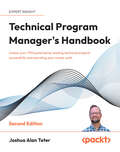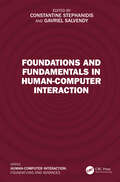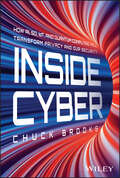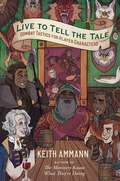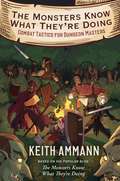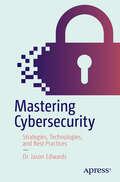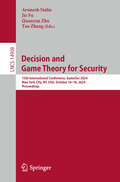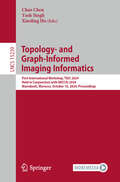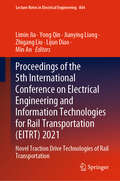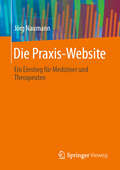- Table View
- List View
Applications of Operational Research in Business and Industries: Proceedings of 54th Annual Conference of ORSI (Lecture Notes in Operations Research)
by Samarjit Kar Angappa Gunasekaran Jai Kishore SharmaEffective decision-making while trading off the constraints and conflicting multiple objectives under rapid technological developments, massive generation of data, and extreme volatility is of paramount importance to organizations to win over the time-based competition today. While agility is a crucial issue, the firms have been increasingly relying on evidence-based decision-making through intelligent decision support systems driven by computational intelligence and automation to achieve a competitive advantage. The decisions are no longer confined to a specific functional area. Instead, business organizations today find actionable insight for formulating future courses of action by integrating multiple objectives and perspectives. Therefore, multi-objective decision-making plays a critical role in businesses and industries. In this regard, the importance of Operations Research (OR) models and their applications enables the firms to derive optimum solutions subject to various constraints and/or objectives while considering multiple functional areas of the organizations together. Hence, researchers and practitioners have extensively applied OR models to solve various organizational issues related to manufacturing, service, supply chain and logistics management, human resource management, finance, and market analysis, among others. Further, OR models driven by AI have been enabled to provide intelligent decision-support frameworks for achieving sustainable development goals.The present issue provides a unique platform to showcase the contributions of the leading international experts on production systems and business from academia, industry, and government to discuss the issues in intelligent manufacturing, operations management, financial management, supply chain management, and Industry 4.0 in the Artificial Intelligence era. Some of the general (but not specific) scopes of this proceeding entail OR models such as Optimization and Control, Combinatorial Optimization, Queuing Theory, Resource Allocation Models, Linear and Nonlinear Programming Models, Multi-objective and multi-attribute Decision Models, Statistical Quality Control along with AI, Bayesian Data Analysis, Machine Learning and Econometrics and their applications vis-à-vis AI & Data-driven Production Management, Marketing and Retail Management, Financial Management, Human Resource Management, Operations Management, Smart Manufacturing & Industry 4.0, Supply Chain and Logistics Management, Digital Supply Network, Healthcare Administration, Inventory Management, consumer behavior, security analysis, and portfolio management and sustainability. The present issue shall be of interest to the faculty members, students, and scholars of various engineering and social science institutions and universities, along with the practitioners and policymakers of different industries and organizations.
Virtual Reality Narratives: Embodied Encounters in Space
by Kath DooleyThis monograph delves into recent evolutions in virtual reality (VR) storytelling, focusing on entertainment-based works created or launched since 2020. Through various case studies, it showcases the increasing diversity and sophistication of recent narrative-based projects. Moving past the initial hype associated with the latest wave of VR, a number of innovative and affective works combining documentary-based or fictional storytelling with game mechanics, live theatre and other elements, have appeared at festivals or on distribution platforms in recent years. These interdisciplinary works have much to tell us about the future of VR storytelling but have yet to receive sustained analysis. This book aims to correct that. Dooley argues that VR, as an interactive medium that places the user inside a storyworld in a visible or invisible virtual body, offers narratives that incorporate the user’s body as a storytelling tool. This fosters user-centred stories that unfold in three-dimensional space. Adopting phenomenological and formal analysis methodologies, the monograph examines case studies through their approaches to narrative, style, and interactive devices. Key concepts that are explored include agency, direct address, environmental and spatial storytelling, embodiment and presence. By providing a much-needed analysis of works through a variety of theoretical lenses, the book illustrates how recent VR storytelling fosters powerfully transformative experiences.
Unternehmensweites Informationsmanagement: Die Rolle der Enterprise Architecture
by Christian M. SchwedaDer Aufbau und die Transformation digitaler Geschäftsmodelle stellen eine Herausforderung für Unternehmen dar. Dieses Buch unterstützt mit praxiserprobten Bausteinen das Management digitaler Geschäftsmodelle sowie die Gestaltung einer Unternehmensarchitektur, die diese Geschäftsmodelle möglich macht. Es ordnet die Best Practices in einem Framework an, das Prinzipien von ArchiMate, TOGAF und COBIT aufgreift und auf wesentliche Grundgedanken (Axiome) zusammenführt. Diese Axiome ermöglichen es, die Best Practices an die konkreten Gegebenheiten von Unternehmen anzupassen. Die Best Practices bilden die Grundlage für die Governance der digitalen Transformation sowie ein damit integriertes Management der Gefährdungen und sich daraus ergebende Informationsrisiken. Ein Lehr- und Trainingskonzept für das Management digitaler Geschäftsmodelle sowie eine Forschungsmethode für wissenschaftliche Arbeiten an der Schnittstelle von Praxis und Forschung runden das Buch ab.
Advances on Graph-Based Approaches in Information Retrieval: First International Workshop, IRonGraphs 2024, Glasgow, UK, March 24, 2024, Proceedings (Communications in Computer and Information Science #2197)
by Ludovico Boratto Cataldo Musto Mirko Marras Daniele Malitesta Giacomo Medda Erasmo PurificatoThis book constitutes the refereed proceedings of the First International Workshop on Graph-Based Approaches in Information Retrieval, IRonGraphs 2024, held in Glasgow, UK, on March 24, 2024. The 6 full papers included in this book were carefully reviewed and selected from 14 submissions. They focus on diverse novel contributions, with presentations on knowledge-aware graph-based recommender systems using user-based semantic features filtering, source-target node distance impacts on adversarial attacks in social network recommendations.
Evolution in Computational Intelligence: Proceedings of the 11th International Conference on Frontiers of Intelligent Computing: Theory and Applications (FICTA 2023) (Smart Innovation, Systems and Technologies #370)
by Xin-She Yang Vikrant Bhateja Carlos M. Travieso-Gonzalez Marta Campos Ferreira Sandeep Singh SengarThe book presents the proceedings of the 11th International Conference on Frontiers of Intelligent Computing: Theory and Applications (FICTA 2023), held at Cardiff School of Technologies, Cardiff Metropolitan University, Cardiff, Wales, UK, during April 11–12, 2023. Researchers, scientists, engineers, and practitioners exchange new ideas and experiences in the domain of intelligent computing theories with prospective applications in various engineering disciplines in the book. This book is divided into two volumes. It covers broad areas of information and decision sciences, with papers exploring both the theoretical and practical aspects of data-intensive computing, data mining, evolutionary computation, knowledge management and networks, sensor networks, signal processing, wireless networks, protocols, and architectures. This book is a valuable resource for postgraduate students in various engineering disciplines.
Meilensteine und Entwicklungen der KI: Technische Herausforderungen sowie aktuelle ethische, soziale und gesellschaftspolitische Fragestellungen (FOM-Edition)
by Markus H. Dahm Carsten HagemannDieses Buch bietet einen umfassenden Überblick über die Entstehung und den aktuellen Stand der KI. Der interdisziplinäre Ansatz erlaubt einen ganzheitlichen Blick auf das Thema. Die Autoren bilden die Entwicklung, die damit einhergehenden Schwierigkeiten und Erfolge sowie den Einfluss der technologischen Entwicklung auf die Realisierung von KI-Systemen ab. Im Fokus stehen nicht nur technologische Aspekte, sondern auch ethische, soziale und wirtschaftliche Fragestellungen rund um die KI. Die Leserinnen und Leser werden dazu angeregt, über diese Herausforderungen nachzudenken, um aktiv an der Diskussion über die Rolle der KI in unserer Gesellschaft teilnehmen zu können.
Perinatal, Preterm and Paediatric Image Analysis: 9th International Workshop, PIPPI 2024, Held in Conjunction with MICCAI 2024, Marrakesh, Morocco, October 6, 2024, Proceedings (Lecture Notes in Computer Science #14747)
by Christopher Macgowan Andrew Melbourne Roxane Licandro Jana Hutter Esra Abaci Turk Daphna Link-SouraniThis book constitutes the refereed proceedings of the 9th International Workshop on Perinatal, Preterm and Paediatric Image Analysis, PIPPI 2024, held in conjunction with the 27th International Conference on Medical Imaging and Computer-Assisted Intervention, MICCAI 2024, in Marrakesh, Morocco, on October 6, 2024. The 14 full papers presented in this book were carefully reviewed and selected from 17 submissions. The methods presented in these proceedings cover the full scope of medical image analysis including segmentation, registration, classification, reconstruction, population analysis and advanced structural, and functional and longitudinal modeling, all with an application to younger cohorts.
Pro Oracle SQL Development: Best Practices for Writing Advanced Queries
by Jon HellerWrite SQL statements that are more powerful, simpler, and faster using the advanced features of Oracle SQL. This updated second edition includes the newest advanced features: improved data structures (such as more JSON support and more table options), improved automated processes (such as automatic indexing), and improved SQL language extensions (such as polymorphic table functions, SQL macros, and the multilingual engine).Pro Oracle SQL Development is for anyone who already knows Oracle SQL and is ready to take their skills to the next level. This book provides a clearer way of thinking about SQL by building sets, and it provides practical advice for using complex features while avoiding anti-patterns that lead to poor performance and wrong results. Relevant theories, real-world best practices, and style guidelines help you get the most out of Oracle SQL.Many developers, testers, analysts, and administrators use Oracle databases frequently, but their queries are limited because they do not take advantage of Oracle’s advanced features. This book inspires you to achieve more with your Oracle SQL statements by creating your own style for writing simple, yet powerful, SQL. It teaches you how to think about and solve performance problems in Oracle SQL, and it covers enough advanced topics to put you on the path to becoming an Oracle expert.What You'll LearnSolve challenging problems with declarative SQL instead of procedural languagesWrite SQL statements that are large and powerful, but also elegant and fastCreate development environments that are simple, scalable, and conducive to learningVisualize and understand SQL more intuitivelyApply advanced syntax, objects, and architectureAvoid SQL anti-patterns that accumulate technical debtTune SQL statements with multiple strategies that can significantly improve performanceWho This Book Is ForDevelopers, testers, analysts, and administrators who want to harness the full power of Oracle SQL to solve their problems as simply and as quickly as possible; traditional database professionals looking for new ways of thinking about the language they have used for so long; and modern full stack developers who need an explanation of how a database can be much more than simply a place to store data
Generative AI: Phishing and Cybersecurity Metrics (Cyber Shorts)
by Ravindra DasThe cybersecurity landscape is changing, for sure. For example, one of the oldest threat variants is that of phishing. It evolved in the early 1990s, but even today it is still being used as a primary threat variant and has now become much more sophisticated, covert, and stealthy in nature. For example, it can be used to launch ransomware, social engineering, and extortion attacks.The advent of Generative AI is making this much worse. For example, a cyberattacker can now use something like ChatGPT to craft the content for phishing emails that are so convincing that it is almost impossible to tell the difference between what is real and what is fake. This is also clearly evident in the use of deepfakes, where fake images of real people are replicated to create videos to lure unsuspecting victims to a fake website.But Generative AI can also be used for the good to combat Phishing Attacks. This is the topic of this book. In this, we cover the following: A review of phishing A review of AI, Neural Networks, and Machine Learning A review of Natural Language Processing, Generative AI, and the Digital Person A proposed solution as to how Generative AI can combat phishing attacks as they relate to Privileged Access accounts
Soft Computing in Renewable Energy Technologies (Advances in Digital Technologies for Smart Applications)
by Sanjeevikumar Padmanaban Mariya Ouaissa Mahmoud A. Mossa Najib El Ouanjli Said MahfoudThis book addresses and disseminates state-of-the-art research and development in the applications of soft computing techniques for renewable energy systems. It covers topics such as solar energy, wind energy, and solar concentrator technologies, as well as building systems and power generation systems. In all these areas, applications of soft computing methods such as artificial neural networks, genetic algorithms, particle swarm optimization, cuckoo search, fuzzy logic, and a combination of these, called hybrid systems, are included. This book is a source for students interested in the fields of renewable energy and the application of the soft computing. In addition, our book can be considered as a reference for researchers and academics since it will include applications of soft computing in different renewable energy systems.
Computational Methods in Science and Technology: Proceedings of the 4th International Conference on Computational Methods in Science & Technology (ICCMST 2024), 2–3 May 2024, Mohali, India, Volume 1
by Manish Kumar Arvind Dagur Dhirendra Kumar Shukla Sukhpreet Kaur Sushil KambojThis book contains the proceedings of the 4TH International Conference on Computational Methods in Science and Technology (ICCMST 2024).The proceedings explores research and innovation in the field of Internet of things, Cloud Computing, Machine Learning, Networks, System Design and Methodologies, Big Data Analytics and Applications, ICT for Sustainable Environment, Artificial Intelligence and it provides real time assistance and security for advanced stage learners, researchers and academicians has been presented.This will be a valuable read to researchers, academicians, undergraduate students, postgraduate students, and professionals within the fields of Computer Science, Sustainability and Artificial Intelligence.
Zelda the Gamer Fairy (Rainbow Magic #80)
by Daisy MeadowsWhen jealous Jack Frost steals Zelda the Gamer Fairy's magical headset, controller and console, video games everywhere begin to glitch and gaming is ruined! With the help of Rachel, Kirsty, Gracie and Khadijah, Zelda must venture through the Land of Games and play to win back her enchanted objects so that gaming can be fun again.'These stories are magic; they turn children into readers!' ReadingZone.comIf you like Rainbow Magic, check out Daisy Meadows' other series: Pixie Magic, Unicorn Magic and Magic Animal Friends!
The Minimum Core for Information and Communication Technology: Audit And Test (Achieving QTLS Series)
by Alan ClarkeThe teacher training framework, introduced in September 2007, requires all teachers in the post-16 sector to possess knowledge, understanding and personal skills to at least level 2 in the minimum core for ICT. Coverage and assessment of the minimum core have to be embedded in all Certificate and Diploma courses leading to QTLS and ATLS status. This book is a practical guide to ICT for trainee teachers in the Lifelong Learning Sector. It enables trainee teachers to identify and develop their own ICT skills and to support their students in ICT.
The Minimum Core for Information and Communication Technology: Audit And Test (Achieving QTLS Series)
by Sandra MurrayThis book supports trainee teachers in the Lifelong Learning Sector in the assessment of their knowledge of ICT. A self-audit section is included to help trainees understand their level of competence and confidence and will help them identify any gaps in their knowledge and skills. This is followed by exercises and activities to support and enhance learning. The book covers all the content of the LLUK standards for the minimum core for information and communication technology. Coverage and assessment of the core have to be embedded in all Certificate and Diploma courses leading to QTLS and ATLS status.
Technical Program Manager's Handbook: Unlock your TPM potential by leading technical projects successfully and elevating your career path
by Joshua Alan TeterExplore the TPM role in depth with this revised second edition. New coverage includes advanced program management techniques, emotional intelligence, and AI integration. Join business with technology and elevate your career.Key FeaturesLearn advanced system design principles and architectural concepts necessary for a TPMGet up to speed with AI-driven project planning, risk management, and stakeholder communication toolsBenefit from practical tools, methodologies, case studies, and real-world examplesBook DescriptionThe role of the Technical Program Manager (TPM) is crucial in the tech industry, bridging the gap between technical expertise and business acumen. The second edition of the Technical Program Manager’s Handbook offers a comprehensive guide to excelling in this role. Building on the foundational concepts from the first edition, this updated version introduces new chapters that explore the integration of AI and Emotional Intelligence (EI) in program management. These crucial additions complement the broader focus of the book on bridging business and technology but don’t overshadow it. You'll learn how to apply AI-driven tools to enhance project planning, risk management, and stakeholder communication, as well as how to leverage EI to build strong team relationships and improve leadership effectiveness. This book provides practical tools, methodologies, and case studies, offering insights from industry leaders to help both aspiring and practicing TPMs apply advanced concepts and strategies effectively. It also explores the unique aspects of the TPM role in major tech companies, helping you to navigate and thrive in your career. By the end of this book, you'll have a clear understanding of the TPM role, along with a breakdown of the necessary technical and program management skills, to develop a clear roadmap for your career.What you will learnUncover the critical importance of the TPM role in the tech industryUnderstand and leverage the unique aspects of the TPM roleDiscover what makes a successful TPM through real-world case studiesMaster project management with advanced technical skills and AI toolsApply EI to enhance leadership and team managementExplore careers and paths for TPMs in the Big Five tech companiesWho this book is forThis book is designed for aspiring and established Technical Program Managers (TPMs), tech professionals transitioning into TPM roles, and recent graduates embarking on careers in technology consulting. It's also valuable for business analysts, project managers, and anyone supporting or working alongside TPMs. To fully benefit from this book, readers should have a basic understanding of the project management life cycle and be comfortable with technical concepts, as it dives into advanced topics and real-world applications.
Foundations and Fundamentals in Human-Computer Interaction
by Gavriel Salvendy Constantine StephanidisThis book serves as a foundation to the field of HCI, equipping readers with the necessary knowledge and skills to engage in this field. This book Discusses human functionalities and characteristics relevant to interaction, including sensory perception, attention and memory, language and communication, emotions, decision-making, as well as mental models, human error, and human actions. Explores the evolution of HCI design approaches and the role of social and organizational psychology in HCI Discusses key concepts and societal aspects of interactive technologies, such as user acceptance, ethics, privacy, and trust. Covers the historical background, contributing disciplines, essential concepts, and theories within the domain. This book will appeal to individuals interested in Human–Computer Interaction research and applications.
Inside Cyber: How AI, 5G, IoT, and Quantum Computing Will Transform Privacy and Our Security
by Chuck BrooksDiscover how to navigate the intersection of tech, cybersecurity, and commerce In an era where technological innovation evolves at an exponential rate, Inside Cyber: How AI, 5G, and Quantum Computing Will Transform Privacy and Our Security by Chuck Brooks emerges as a critical roadmap for understanding and leveraging the next wave of tech advancements. Brooks, a renowned executive and consultant, breaks down complex technological trends into digestible insights, offering a deep dive into how emerging technologies will shape the future of industry and society. In the book, you'll: Gain clear, accessible explanations of cutting-edge technologies such as AI, blockchain, and quantum computing, and their impact on the business world Learn how to navigate the cybersecurity landscape, safeguarding your business against the vulnerabilities introduced by rapid technological progress Uncover the opportunities that technological advancements present for disrupting traditional industries and creating new value Perfect for entrepreneurs, executives, technology professionals, and anyone interested in the intersection of tech and business, Inside Cyber equips you with the knowledge to lead in the digital age. Embrace the future confidently with this indispensable guide.
Live to Tell the Tale: Combat Tactics for Player Characters (The Monsters Know What They’re Doing #2)
by Keith AmmannFrom the author of The Monsters Know What They&’re Doing comes an introduction to combat tactics for Dungeons & Dragons players.In his first book, The Monsters Know What They&’re Doing (based on his popular blog), Keith Ammann unleashed upon the D&D world a wave of clever, highly evolved monster tactics. Now it&’s only fair that he gives players the tools they need to fight back…and prevail! An introduction to combat tactics for fifth-edition Dungeons & Dragons players, Live to Tell the Tale evens the score. It examines the fundamentals of D&D battles: combat roles, party composition, attacking combos, advantage and disadvantage, Stealth and Perception, and more…including the ever-important consideration of how to run away! Don&’t worry about creating a mathematically perfect character from square one. Survival isn&’t about stats—it&’s about behavior! With four turn-by-turn, roll-by-roll, blow-by-blow sample battles, Live to Tell the Tale breaks down how to make the best choices for your cherished characters so that they can survive their adventures, retire upon their accumulated riches, and tell stories about the old days that nobody will ever believe.
The Monsters Know What They're Doing: Combat Tactics for Dungeon Masters (The Monsters Know What They’re Doing #1)
by Keith AmmannFrom the creator of the popular blog The Monsters Know What They&’re Doing comes a compilation of villainous battle plans for Dungeon Masters.In the course of a Dungeons & Dragons game, a Dungeon Master has to make one decision after another in response to player behavior—and the better the players, the more unpredictable their behavior! It&’s easy for even an experienced DM to get bogged down in on-the-spot decision-making or to let combat devolve into a boring slugfest, with enemies running directly at the player characters and biting, bashing, and slashing away. In The Monsters Know What They&’re Doing, Keith Ammann lightens the DM&’s burden by helping you understand your monsters&’ abilities and develop battle plans before your fifth edition D&D game session begins. Just as soldiers don&’t whip out their field manuals for the first time when they&’re already under fire, a DM shouldn&’t wait until the PCs have just encountered a dozen bullywugs to figure out how they advance, fight, and retreat. Easy to read and apply, The Monsters Know What They're Doing is essential reading for every DM.
Wie man Roku jailbreakt: Entsperren Sie Roku, Roku Stick, Roku Ultra, Roku Express, Roku TV mit Kodi
by Jonathan GatesEine Schritt-für-Schritt-Anleitung, wie man Kodi auf allen Roku-Geräten ausführt Eine der besten Funktionen der Roku-Geräte ist, dass man Kodi darauf ausführen kann. Dies ermöglicht Ihnen den Zugang zu allen gewünschten Inhalten wie Fernsehsendungen, Musik und Filmen. Das erhalten Sie: Informationen zu Roku-Geräten Kodi auf Roku-Geräten ausführen Probleme beheben Zugriff auf Filme, Musik und Fernsehsendungen genießen --> Scrollen Sie nach oben auf der Seite und klicken Sie auf "In den Warenkorb", um sofort zu kaufen Haftungsausschluss: Der Autor und/oder die Rechteinhaber machen keine Ansprüche, Versprechungen oder Garantien hinsichtlich der Genauigkeit, Vollständigkeit oder Angemessenheit der Inhalte dieses Buches und lehnen ausdrücklich die Haftung für Fehler und Auslassungen in den Inhalten ab. Dieses Produkt dient nur zu Referenzzwecken.
Mastering Cybersecurity: Strategies, Technologies, and Best Practices
by Dr. Jason EdwardsThe modern digital landscape presents many threats and opportunities, necessitating a robust understanding of cybersecurity. This book offers readers a broad-spectrum view of cybersecurity, providing insights from fundamental concepts to advanced technologies. Beginning with the foundational understanding of the ever-evolving threat landscape, the book methodically introduces many cyber threats. From familiar challenges like malware and phishing to more sophisticated attacks targeting IoT and blockchain, readers will gain a robust comprehension of the attack vectors threatening our digital world. Understanding threats is just the start. The book also delves deep into the defensive mechanisms and strategies to counter these challenges. Readers will explore the intricate art of cryptography, the nuances of securing both mobile and web applications, and the complexities inherent in ensuring the safety of cloud environments. Through meticulously crafted case studies tailored for each chapter, readers will witness theoretical concepts' practical implications and applications. These studies, although fictional, resonate with real-world scenarios, offering a nuanced understanding of the material and facilitating its practical application. Complementing the knowledge are reinforcement activities designed to test and solidify understanding. Through multiple-choice questions, readers can gauge their grasp of each chapter's content, and actionable recommendations offer insights on how to apply this knowledge in real-world settings. Adding chapters that delve into the intersection of cutting-edge technologies like AI and cybersecurity ensures that readers are prepared for the present and future of digital security. This book promises a holistic, hands-on, and forward-looking education in cybersecurity, ensuring readers are both knowledgeable and action-ready. What You Will Learn The vast array of cyber threats, laying the groundwork for understanding the significance of cybersecurity Various attack vectors, from malware and phishing to DDoS, giving readers a detailed understanding of potential threats The psychological aspect of cyber threats, revealing how humans can be manipulated into compromising security How information is encrypted and decrypted to preserve its integrity and confidentiality The techniques and technologies that safeguard data being transferred across networks Strategies and methods to protect online applications from threats How to safeguard data and devices in an increasingly mobile-first world The complexities of the complexities of cloud environments, offering tools and strategies to ensure data safety The science behind investigating and analyzing cybercrimes post-incident How to assess system vulnerabilities and how ethical hacking can identify weaknesses Who this book is for: CISOs, Learners, Educators, Professionals, Executives, Auditors, Boards of Directors, and more.
Decision and Game Theory for Security: 15th International Conference, GameSec 2024, New York City, NY, USA, October 16–18, 2024, Proceedings (Lecture Notes in Computer Science #14908)
by Tao Zhang Quanyan Zhu Arunesh Sinha Jie FuThis book constitutes the refereed proceedings of the 15th International Conference on Decision and Game Theory for Security, GameSec 2024, which took place in New York City, USA, in October 2024. The 15 full papers included in this book were carefully reviewed and selected from 27 submissions. They were organized in topical sections as follows: systems security; economics; equilibrium and control; cyber deception; network and privacy; adversarial machine learning; and cyber-physical systems.
Topology- and Graph-Informed Imaging Informatics: First International Workshop, TGI3 2024, Held in Conjunction with MICCAI 2024, Marrakesh, Morocco, October 10, 2024, Proceedings (Lecture Notes in Computer Science #15239)
by Chao Chen Xiaoling Hu Yash SinghThis book constitutes the proceedings of the First International Workshop on Topology- and Graph-Informed Imaging Informatics, TGI3 2024, held in conjunction with the 27th International conference on Medical Image Computing and Computer Assisted Intervention, MICCAI 2024, in Marrakesh, Morocco in October 2024. The 13 full papers presented here were carefully reviewed and selected. These papers focus on the application of Topological Data Analysis (TDA) techniques, along with other computational techniques, for summarizing, analyzing, quantifying, and visualizing complex medical data for a more effective and efficient analysis.
Proceedings of the 5th International Conference on Electrical Engineering and Information Technologies for Rail Transportation: Novel Traction Drive Technologies of Rail Transportation (Lecture Notes in Electrical Engineering #864)
by Zhigang Liu Limin Jia Yong Qin Lijun Diao Min An Jianying LiangThis book reflects the latest research trends, methods and experimental results in the field of electrical and information technologies for rail transportation, which covers abundant state-of-the-art research theories and ideas. As a vital field of research that is highly relevant to current developments in a number of technological domains, the subjects it covered include intelligent computing, information processing, communication technology, automatic control, etc. The objective of the proceedings is to provide a major interdisciplinary forum for researchers, engineers, academicians and industrial professionals to present the most innovative research and development in the field of rail transportation electrical and information technologies. Engineers and researchers in academia, industry and government will also explore an insightful view of the solutions that combine ideas from multiple disciplines in this field. The volumes serve as an excellent reference work for researchers and graduate students working on rail transportation and electrical and information technologies.
Die Praxis-Website: Ein Einstieg für Mediziner und Therapeuten
by Jörg NaumannIn der digitalen Welt ist eine Website für Praxen unverzichtbar geworden. Aber wie gestalten Sie Ihren Online-Auftritt so, dass er gleichzeitig die Bedürfnisse Ihrer Patienten erfüllt und Sie mit ihm die Ziele Ihrer Praxis erreichen? Der Leitfaden „Die Praxis-Website: Eine Einführung für Mediziner und Therapeuten“ führt Sie ein in die Kunst des patientenzentrierten Webdesigns. Zahnarzt und Webdesigner Dr. Jörg Naumann begleitet Sie durch alle wichtigen Schritte von der inhaltlichen Konzeption über Fragen des passenden Designs bis zur Lesbarkeit und Verständlichkeit Ihrer Texte. Für Websites aus dem medizinischen und therapeutischen Bereich ist Barrierefreiheit wichtig. Besonderes Augenmerk liegt in diesem Ratgeber daher auf Maßnahmen, mit denen Sie Ihren Online-Auftritt für alle zugänglich machen.
